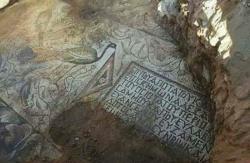INSTITUT SUPERIEUR D'ANTHROPOLOGIE
INSTITUTE OF ANTHROPOLOGY
ONLINE COURSES / COURS A DISTANCE
WINTER TERM : JANUARY 2018
REGISTER NOW
SYRIE –  Hama - Amid the bloody conflict, three Byzantine mosaic panels have been unearthed inside an archaeological site during a Syrian army mine-clearance operation in the eastern countryside of Hama in, according to the state-run Syrian Arab News Agency (SANA). One of the three panels bears a Greek inscription, while the other two have bird and floral motifs. In addition to the three mosaics, a team of archaeologists uncovered the foundations of a church nearby. During a routine mine excavation the Syrian Engineering corps found a unique looking slab of material underneath the earth. After some careful digging what they saw was an ancient Greek mosaic floor, which surprised all involved. Syrian authorities for archaeology were contacted urgently and the process of professional excavation commenced. The floor pieces have been briefly translated by Syrian workers and are being moved after excavations to archaeological laboratories to fully clean and translate the piece. Additional pieces are going to be investigated to get a full picture on the floor. The structure has been calculated to have been in the area for several thousand years and has become very rigid in the earth. Translations have started on the structures and have revealed the connection to Saint Alexander and ‘the most respected bishop Evangelus’. Some of the initial information has led to the following Greek translation becoming available to the public: ΕΠΙΤΟΥΑΓΙΟΥΚΑΙΕΠΙΣΚΗΜΩΝ ΑΛΕΞΑΝΔΡΟΥΤΟΥΟΣΙΟΤΑΤΟΥΠΕΡΙΚΑΜΜΟΥΚΑΙΤΟΥΕΥΛΑΒΕΣΤΑΤΟΥΕΥΑΝΓΕ
Hama - Amid the bloody conflict, three Byzantine mosaic panels have been unearthed inside an archaeological site during a Syrian army mine-clearance operation in the eastern countryside of Hama in, according to the state-run Syrian Arab News Agency (SANA). One of the three panels bears a Greek inscription, while the other two have bird and floral motifs. In addition to the three mosaics, a team of archaeologists uncovered the foundations of a church nearby. During a routine mine excavation the Syrian Engineering corps found a unique looking slab of material underneath the earth. After some careful digging what they saw was an ancient Greek mosaic floor, which surprised all involved. Syrian authorities for archaeology were contacted urgently and the process of professional excavation commenced. The floor pieces have been briefly translated by Syrian workers and are being moved after excavations to archaeological laboratories to fully clean and translate the piece. Additional pieces are going to be investigated to get a full picture on the floor. The structure has been calculated to have been in the area for several thousand years and has become very rigid in the earth. Translations have started on the structures and have revealed the connection to Saint Alexander and ‘the most respected bishop Evangelus’. Some of the initial information has led to the following Greek translation becoming available to the public: ΕΠΙΤΟΥΑΓΙΟΥΚΑΙΕΠΙΣΚΗΜΩΝ ΑΛΕΞΑΝΔΡΟΥΤΟΥΟΣΙΟΤΑΤΟΥΠΕΡΙΚΑΜΜΟΥΚΑΙΤΟΥΕΥΛΑΒΕΣΤΑΤΟΥΕΥΑΝΓΕ
The reference to religious figures has pointed towards the possibility of the area being the site of a larger religious building and as a result the area has become an archaeological site. The Syrian Army is continuing very careful work to de-mine the rest of the area to allow for further investigations. The chief of the Antiquities and Museums Department in Hama, Abdul-Qader Farzat, told SANA the site is a church floor dating back to the fifth century AD. Excavations initiated after information about the existence of an archaeological site buried in the vicinity of Uqerbat, located 85 kilometers (52 miles) east of Hama city.
http://www.tornosnews.gr/en/greek-news/culture/29501-ancient-greek-mosaic-floor-found-unearthed-in-war-torn-syrian-city-of-hama.html
BELGIQUE –  Tournai - Des vestiges découverts lors des travaux d'élargissement de l'Escaut, à Tournai, pourraient être ceux de l'ancien pont aux Pommes qui a existé jusqu'en 1940. Les massifs de maçonnerie et de pierre qui ont été mis au jour un peu en aval du pont-à-Ponts font plus que probablement partie des fondations du précédent pont (que l’on appelait alors encore « pont aux pommes »). Un pont levant existait à cet endroit de 1925 à 1940, quand il a été démoli. Le pont actuel avait été reconstruit vers 1946." Son nom, le pont aux Pommes l'aurait acquis suite au déménagement en 1653, du marché aux pommes de la Grand-Place vers le quai.Un nom qui aurait alors été transmis aux différents ponts construits sur le site par la suite. Quant à l'appellation de Pont à Pont, elle proviendrait du fait que l'un de ces ouvrages était jadis composé de plusieurs arches donnant l'impression de ponts se succédant.
Tournai - Des vestiges découverts lors des travaux d'élargissement de l'Escaut, à Tournai, pourraient être ceux de l'ancien pont aux Pommes qui a existé jusqu'en 1940. Les massifs de maçonnerie et de pierre qui ont été mis au jour un peu en aval du pont-à-Ponts font plus que probablement partie des fondations du précédent pont (que l’on appelait alors encore « pont aux pommes »). Un pont levant existait à cet endroit de 1925 à 1940, quand il a été démoli. Le pont actuel avait été reconstruit vers 1946." Son nom, le pont aux Pommes l'aurait acquis suite au déménagement en 1653, du marché aux pommes de la Grand-Place vers le quai.Un nom qui aurait alors été transmis aux différents ponts construits sur le site par la suite. Quant à l'appellation de Pont à Pont, elle proviendrait du fait que l'un de ces ouvrages était jadis composé de plusieurs arches donnant l'impression de ponts se succédant.
http://www.lavenir.net/cnt/dmf20180115_01111499?pid=3589674